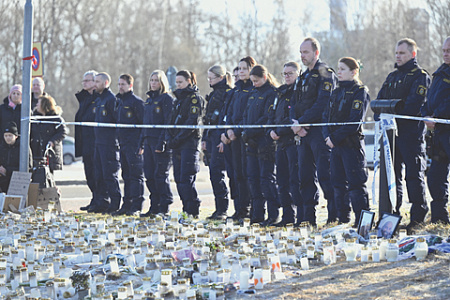
On February 4, the most massive murder in the country’s recent history took place in the Swedish city of Örebro. 35-year-old Rikard Andersson shot 10 people and died in the incident. Prior to that, the largest school crime in the country was the actions of 21-year-old Anton Petterson, who on October 22, 2015, killed three people with a cold weapon in the city of Trollhattan. The incident was labeled by the police as a “hate crime”, but not as a terrorist attack, which sparked a discussion about double standards in the Swedish law enforcement system.
But if Petterson was inspired by the example of Norwegian Anders Breivik and other far-right extremists, believing that Sweden has been invaded by immigrants and the government ignores the interests of citizens, then in the case of the tragedy in Örebro, the motives of the perpetrator are still unknown and are more likely due to his mental disorder and social isolation. However, this did not prevent Andersson from obtaining licenses for four hunting weapons in 2011-2014.
In a speech to the nation on February 9, Prime Minister Ulf Kristersson preferred to abandon speculation about the motives of the perpetrator, but nevertheless stressed that the concerns of people of immigrant origin should be treated with understanding and respect.
Crimes committed by people with psychological disabilities may not always be classified as terrorism, and the attackers may not be prosecuted. But for the Nordic countries, this problem is acute, and the damage from it sometimes turns out to be even greater than from the actual terrorist attacks.
The tragedy in Örebro came as a surprise, but the prerequisites had been brewing for a long time. So, in August 2021, January and March 2022, three schools in southern Sweden were unsuccessfully attacked by “shooters”, and in June 2022, the government decided to prepare a series of expert reports and recommendations to strengthen school security. The final one was presented in December 2024, and not all the proposals contained in it have begun to be implemented in practice.
For the Nordic countries, the contradiction between the promotion of freedom of speech, tolerance and liberal values and the effective fight against right-wing extremism and terrorism will remain acute in the future. They were among the first in Europe to ban statements inciting hatred against racial and ethnic groups. Denmark introduced such a ban in 1939 against the background of Nazi Germany’s anti–Semitic propaganda, Norway in 1961 during a new wave of anti-Jewish sentiment in Western Europe, and Sweden in 1949 for the same reason. In Finland, the ban appeared in 1970, after the International Convention on the Elimination of All Forms of Racial Discrimination, adopted by the UN General Assembly in 1965, came into force.
At the same time, the situation in Sweden is complicated by the fact that there are no systematic official statistics on crimes committed by immigrants of different generations. Although some studies prepared by the Swedish Council for the Prevention of Offenses have been published. It was believed that the publication of such statistics would not solve the crime problem, but would only increase xenophobia and “us-them” thinking in society. At the same time, the lack of a clear analysis of the structure of crime and its sources negatively affects the effectiveness of police work.
It is noteworthy that after the Swedish tragedy, certain parties of the “blue bloc” in Denmark (the Liberal Alliance, the Danish Democrats, the Conservative People’s Party and the Danish People’s Party) called for the repeal of the law passed in December 2023 prohibiting public abuse of sacred texts. As well as for the repeal of article 266b of the Danish Criminal Code, which prohibits incitement to hatred and the spread of false rumors and accusations against social groups in connection with their religion and ethnic origin. However, they are based not on the school shooting in Erebra, but on the recent murder of Salman Monica, an Iraqi immigrant who staged demonstrative burning of the Koran. But the coincidence of these two events is not accidental.
It is likely that what happened in Örebro will serve as an additional argument in favor of strengthening the work of Swedish law enforcement and social services. At the same time, journalists were outraged by the fact that many foreign media outlets draw parallels between the growth of organized crime in the country and Andersson’s actions, although in reality there is no direct link between these social phenomena.
The discussion focused on regulating the licensing and sale of hunting weapons, especially semi-automatic AR-15 rifles, to Swedish citizens, although there is still no definitive confirmation that Andersson used these weapons. In Sweden, it has been allowed for purchase for hunting purposes since August 1, 2023.
Last Friday, the ruling parties and the far-right Sweden Democrats called for stricter rules on the arms trade and a complete ban on the AR-15, although they had previously opposed such a step. On the same day, however, this decision caused serious disputes between the party leadership and ordinary members of the Sweden Democrats, who considered it hasty and not in the interests of their constituents. After all, the problem, in their opinion, is not the purchase of weapons for hunting, a popular hobby for many Swedes, but the fight against illegal trafficking in small arms, which is growing simultaneously with organized crime.
The ruling Moderate Coalition Party is facing a similar dilemma, on the one hand, fighting global criminal networks entrenched in Sweden, the source of which was immigration, and on the other, calling for public unity and solidarity in the face of the tragedy in Örebro.
